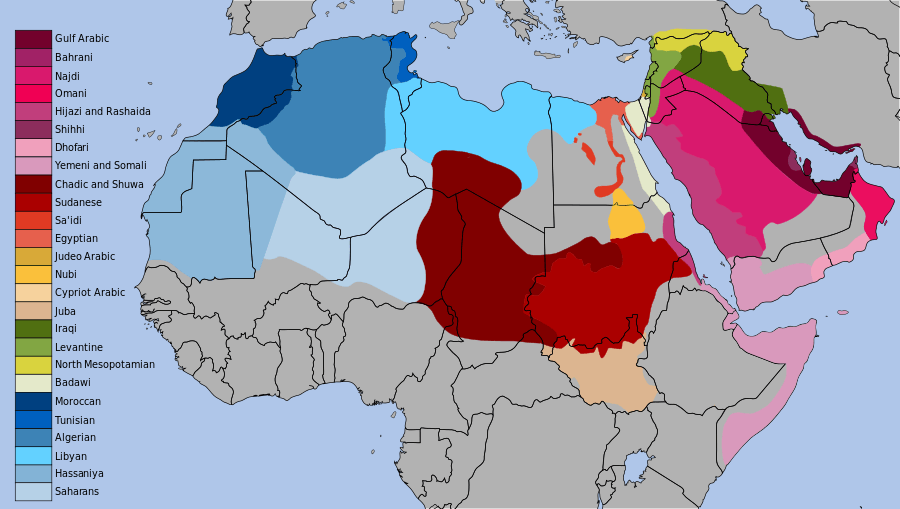North Mesopotamian Arabic
North Mesopotamian Arabic (also known as Moslawi [meaning 'of Mosul'] or Mesopotamian Qeltu Arabic) is a variety of Mesopotamian Arabic spoken north of the Hamrin Mountains in Iraq, in western Iran, northern Syria, and in southeastern Turkey (in the eastern Mediterranean Region, Southeastern Anatolia Region, and southern Eastern Anatolia Region).[3] Like other Mesopotamian Arabic varieties and Levantine Arabic, it shows signs of an Aramaic substrate.[4]
| North Mesopotamian Arabic | |
|---|---|
| Native to | Iraq, Iran, Syria, Turkey, Cyprus |
Native speakers | (8.7 million cited 1992-2014)[1] |
Afro-Asiatic
| |
| Arabic alphabet | |
| Language codes | |
| ISO 639-3 | ayp |
| Glottolog | nort3142[2] |
 Yellow: North Mesopotamian Arabic | |
Cypriot Arabic shares a number of common features with North Mesopotamian Arabic, and one if its pre-Cypriot medieval antecedents has been deduced as belonging to this dialect area.[5][6] However, its current form is a hybrid of different varieties and languages, including Levantine Arabic and Greek.[5]
North Mesopotamian Arabic was once spoken in all of Mesopotamia including what is today Southern Iraq and Khuzestan in Iran (Babylon), the Mesopotamian Gelet was created because of a migration of Bedouins into south and central Mesopotamia after the Mongol invasion. Judeo-Iraqi Arabic is the only remnant of North Mesopotamian that was spoken in the south and represents the pre Mongol invasion Jewish dialects that shows more influence of Akkadian and Eastern Aramaic in them.
Phonology
Vowels
Consonants
Even in the most formal of conventions, pronunciation depends upon a speaker's background.[7] Nevertheless, the number and phonetic character of most of the 28 consonants has a broad degree of regularity among Arabic-speaking regions. Note that Arabic is particularly rich in uvular, pharyngeal, and pharyngealized ("emphatic") sounds. The emphatic coronals (/sˤ/, /tˤ/, and /ðˤ/) cause assimilation of emphasis to adjacent non-emphatic coronal consonants. The phonemes /p/ ⟨پ⟩ and /v/ ⟨ڤ⟩ (not used by all speakers) are not considered to be part of the phonemic inventory, as they exist only in foreign words and they can be pronounced as /b/ ⟨ب⟩ and /f/ ⟨ف⟩ respectively depending on the speaker.
| Labial | Dental | Denti-alveolar | Palatal | Velar | Uvular | Pharyngeal | Glottal | |||
|---|---|---|---|---|---|---|---|---|---|---|
| plain | emphatic1 | |||||||||
| Nasal | m | n | ||||||||
| Stop | voiceless | (p) | t | tˤ | k | q | ʔ | |||
| voiced | b | d | ||||||||
| Fricative | voiceless | f | θ | s | sˤ | ʃ | x ~ χ | ħ | h | |
| voiced | (v) | ð | z | ðˤ | ɣ ~ ʁ | ʕ | ||||
| Affricate | voiceless | tʃ | ||||||||
| voiced | d͡ʒ | |||||||||
| Tap | ɾ | |||||||||
| Approximant | l | (ɫ) | j | w | ||||||
Phonetic notes:
See also
References
- "Arabic, North Mesopotamian Spoken". Ethnologue. Retrieved 2018-08-08.
- Hammarström, Harald; Forkel, Robert; Haspelmath, Martin, eds. (2017). "North Mesopotamian Arabic". Glottolog 3.0. Jena, Germany: Max Planck Institute for the Science of Human History.
- Raymond G. Gordon Jr., ed. 2005. Ethnologue: Languages of the World. 15th edition. Dallas: Summer Institute of Linguistics.
- R. J. al-Mawsely, al-Athar, al-Aramiyyah fi lughat al-Mawsil al-amiyyah (Lexicon: Aramaic in the popular language of Mosul): Baghdad 1963
- Versteegh, Kees (2001). The Arabic Language. Edinburgh University Press. p. 212. ISBN 0-7486-1436-2.
- Owens, Jonathan (2006). A Linguistic History of Arabic. Oxford University Press. p. 274. ISBN 0-19-929082-2.
- Holes (2004:58)
External links
- George Grigore: The Spoken Arabic of Mardin
- George Grigore and Gabriel Bițună: Common Features of North Mesopotamian Arabic Dialects Spoken in Turkey
